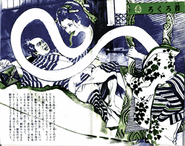| Rokurokubi | ||
| File:Rokurokubi.jpg | ||
| Information | ||
|---|---|---|
| Romanized | Rokurokubi | |
| Kanji | 轆轤首 | |
| Kana | ろくろくび | |
| Meaning | Pulley neck | |
| Type | Human form | |
| Book(s) | Gazu Hyakki Yagyō | |
Rokurokubi (轆轤首, Rokurokubi) is a type of Japanese yōkai. They often appear in classical kaidan and essays, and they are often the subject of yōkai depictions, but it has also been pointed out that they may have simply been created as a pastime for inventing supernatural stories.
Description
Tales of "when people sleep, their necks would stretch" started appearing in the Edo period and afterwards, in literature such as "Buya Zokuda" (武野俗談), "Kanden Kōhitsu" (閑田耕筆』), "Yasō Kidan" (夜窓鬼談), etc.
This type of rokurokubi comes from legends that say that the rokurokubi (nukekubi) have a spiritual string-like object connecting the head to the torso, and it can be said that this type originates from people mistaking the string (depicted in works by people like Sekien) for an elongated neck.
In the "Kasshi Yawa" (甲子夜話), there is the following tale. A certain female student was suspected to be a rokurokubi, and when this servant's master went to check on her when she was sleeping, something like steam gradually rose from her chest, and when it became quite thick, her head would disappear, and right before one's eyes, her appearance turned into one with her neck risen up and stretched. Perhaps because she noticed the presence of her surprised master, when the female servant turned over in bed, her neck returned to normal. This female servant was ordinary and other than the fact that she had a pale face, she was no different from an ordinary human, but her master dismissed her. She was always fired wherever she went, and thus had no luck with finding places of employment. This "Kasshi Yawa" and the aforementioned "Hokusō Sadan" where the souls that leave the body would create the shape of a neck, has sometimes been interpreted as a type of "ectoplasm" in psychic research.
In the yomihon "Rekkoku Kaidan Kikigaki Zōshi" (列国怪談聞書帖) by the popular writer Jippensha Ikku in the late Edo period, rokurokubi are stated to be from human's karma. A certain monk from Enshū named Kaishin and a woman named Oyotsu eloped, but since Oyotsu collapsed due to illness, and since they ran out of money for the journey, he killed her. Afterwards, when Kaishin returned to secular life, when he and a girl of an inn he stayed at became attracted to each other and slept together, the girl's neck stretched and her face turned into Oyotsu, and told him about her resentment. Kaishin became regretful of the past, and spoke about everything to the girl's father. When he did so, the father said that he also killed a woman in the past and stole her money, and used the money to start that inn, but the girl that was born afterwards, due to karma, naturally became a rokurokubi. Kaishin once again entered Buddhist priesthood, and built a grave for Oyotsu, and it is said to be the "Rokurokubi Mound" (ろくろ首の塚, Rokurokubi no Tsuka), telling the story to people afterwards.
There is also the story that rokurokubi are not yōkai, but rather humans with a type of abnormal body condition, and the Edo Period essay "Kanden Kōhitsu" by Ban Kōkei gave an example of a story where in Shin Yoshiwara, a certain geisha had her neck stretch during sleep, stating that it was a body condition where her heart would come loose and neck would stretch.
It was not merely in literature, but also in oral traditions that rokurokubi are talked about, and in a former highway between the village of Iwa and Akechi of Gifu Prefecture, it is said that a snake shapeshifted into a rokurokubi. According to an oral tradition in Koikubo of Iida, Nagano Prefecture, it is said that a rokurokubi appeared in someone's home.
In the Bunka period, a kaidan story became popular, where a certain prostitute co-slept with guests, and when the guest fell asleep, her neck would smoothly stretch and would lick the oil of paper lanterns, and thus rokurokubi were talked about as things that women transform into like this, or a type of srange disease. Also in this time period, rokurokubi gained much popularity as something shown in freak shows. According to the "Shohō Kenbunroku" (諸方見聞録), there was a statement that in 1810 (Bunka 7) a freak show house in a section of Edo actually had a male with a long neck who was famed as a rokurokubi.
Even going into the Meiji period, there are tales of rokurokubi. In the beginning of Meiji, it is said that a certain couple of a merchant family in the town of Shibaya, Ibaraki, Osaka Prefecture witnessed their daughter's neck stretch every night, and there was no effect even when upon relying on Shinto and Buddhism, and eventually the people in the town also came to know of this, and as the couple became unable to endure staying there, they moved away, leaving no notice of their whereabouts.
Gallery
References
- Rokurokubi on Wikipedia
- Rokurokubi on Yokai.com


